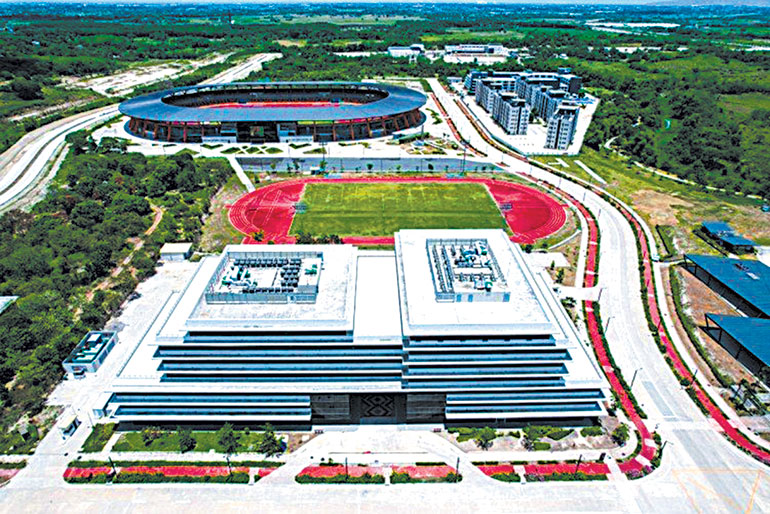Central developments driving the future of cities

In the modern day, cities have evolved into economic powerhouses that drive growth and transformation. These cities house numerous businesses, households, and institutions, which — together with well-rounded transit and spaces — are designed to provide individuals with the best of living.
As a builder of great cities, the Bases Conversion and Development Authority (BCDA) has put urban transformation into action as seen in Bonifacio Global City and Newport City in Metro Manila. Nonetheless, such transformation is much more seen in Clark, at the heart of Central Luzon.
Beyond the metro, BCDA has brought urban transformation in what was once Clark Air Base in Pampanga, turning it into a modern metropolis that has been named as one of the world’s “Cities of Legacy.”
While the Clark Freeport Zone is uniquely built as an economic zone, it previously played a significant role in military operations here in the Philippines. Established in 1920, it initially served as an air base for the US military, known as Fort Stotsenburg. Later, it was renamed Clark Field, in honor of Major Harold Clark, then Clark Air Base.
Today, known as the Clark Freeport and Special Economic Zone (CFEZ), it has transformed into a key economic hub, driving growth and development in the country. It hosts a diverse range of industries, including aviation, business, logistics, tourism, and many more. Managed by the Clark Development Corp. (CDC), the CFEZ continues to expand economic opportunities and activities in the region.
CFEZ has recently seen impressive growth. According to BCDA’s 2023 Annual Report, Clark recorded 3 million tourist arrivals, alongside 138,364 employees, 1,187 locators, and 8 completed infrastructure projects, among others.
The zone is also home to locators from various industries. These include batteries manufacturer StB Capital Partners (St Baker), which recently inaugurated the Philippines’ first manufacturing gigafactory for electronic vehicle batteries, StB Gigafactory, within the area; semiconductor assembly and test company SFA Semicon Philippines Corp.; hotel brands Hilton and Marriott; aircraft interiors and components supplier Jamco; boutique airline Sunlight Air; consumer goods company Luenthai; and logistics leaders FedEx and UPS.
The Clark Freeport Zone is currently envisioned to serve as a central hub for business, leisure, tourism, and more importantly, a home for the meetings, incentives, conventions, and exhibits (MICE) market.
Among the projects currently being undertaken towards this vision are the Clark International Airport Complex, Clark National Food Terminal, and the Clark Entertainment and Events Center. In addition, the zone will house an extension of the National Museum of the Philippines (NMP), the NMP Clark Museum, at the former Clark Air Base Hospital. Exhibiting the rich history of Clark, along with the natural and cultural heritage of the region, the museum will also showcase galleries for anthropology, archeology, and natural history.
Clark International Airport

Alongside economic zones, Clark is also home to the Clark International Airport (CRK), which aims to position Clark as a premier global aviation capital.
Located at the Clark Aviation Complex, CRK is leading the aviation industry by connecting both local and international arrivals. Currently, it hosts 17 airlines, 12 of which fly to international destinations, while five are flying to domestic locations. In 2024, CRK experienced significant passenger growth, welcoming 2.4 million passengers and 19,22 flights — an increase of 20% and 29%, respectively, compared to 2023.
As an aviation-centric business hub, the airport continues to expand to keep pace with aircraft movement, cater to more logistics operations, and enhance the overall airport operations and functions.
At present, the airport is focusing on the development of taxiways, aprons, landside access roads, and utilities. To further enhance convenience for travelers, CRK Direct Access Link is set to connect two expressways, the Subic-Clark-Tarlac Expressway and the North Luzon Expressway.
New Clark City
Adding to the modernization of Clark is the rise of New Clark City — a 9,450-hectare community in Bamban and Capas in Tarlac that will set the standard for a modern, smart, resilient, and sustainable metropolis.
New Clark City was first conceptualized in 2012, and development for the project began in 2016. Aiming to be “a place where nature, leisure and recreation, business and industry, culture and education converge,” New Clark City seeks to create a modern lifestyle for modern citizens with its world-class infrastructure, smart and green buildings, public transport, walkways, and green spaces.
Among the first notable locators were Filinvest Land Corp., which developed Filinvest New Clark City, and the Hann Development Corp., with Hann Reserve. Hann Reserve is a luxury mountain resort development that houses premier hotel brands and champions leisure, luxury living, and eco-tourism; while Filinvest New Clark is a township that combines nature, technology, and architecture within the city.
Other early key infrastructure developments within the city include the National Government Administrative Center and the New Clark City Athletics Stadium.
New Clark City is also home to many academic institutions, including the National Academy of Sport, the University of the Philippines-New Clark City, and the Virology and Vaccine Institute of the Philippines. The establishment of these institutions demonstrates New Clark’s commitment to academic excellence, which is essential for developing a skilled workforce necessary for economic growth.
New Clark City also boasts residential complexes that bring affordable housing to Filipinos. One notable initiative is the 34-hectare housing project, with key elements, such as parks, commercial developments, and convenient access to transport systems. In line with this vision, BCDA is partnering with a consortium of South Korean and local companies, namely Sta. Clara International Corp. (SCIC), Saekyung Realty Corp., and Korea Overseas Infrastructure and Urban Development Corp. (KIND), to develop a 6-hectare housing complex in New Clark City. The complex will feature 12 residential buildings, along with retail and commercial spaces, sports and leisure facilities, parks and other green spaces, and climate-resilient solutions. — Angela Kiara S. Brillantes


